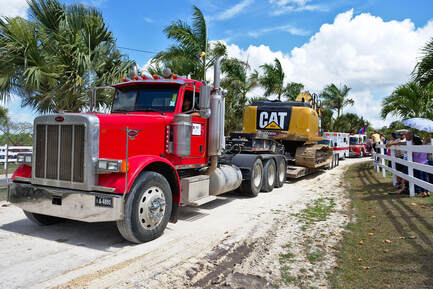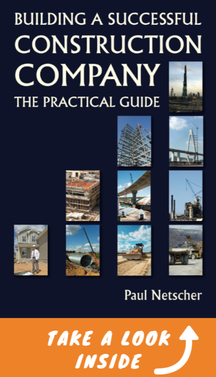"Moving construction equipment requires planning so it is done safely." Moving construction equipment can be complicated, requiring careful planning and execution to guarantee both the safety of personnel and the protection of valuable machinery. Whether you're relocating equipment within a construction site or transporting it to a new location, proper procedures are essential to prevent accidents and damage. Follow some top tips for moving heavy construction equipment safely. Moving heavy construction equipment safely Before moving any construction equipment, it's crucial to assess the potential risks and hazards associated with the task. Identify obstacles, such as uneven terrain, overhead obstacles, or narrow passages, that could pose challenges during the move. Evaluate environmental factors, like weather conditions, that may impact safety. By conducting a comprehensive risk assessment, you can develop strategies to mitigate potential dangers and guarantee a smooth moving process for your construction equipment. "Identify obstacles which could derail moving your construction equipment." Use the right equipment and accessoriesSelecting the appropriate equipment and accessories is crucial for safe transport when moving heavy construction equipment. Utilize heavy-duty trailers, trucks, or cranes capable of supporting the weight and size of the machinery being moved. Use quality straps, chains, or slings to secure the construction equipment firmly during transit, reducing the risk of shifting or tipping. Also, do not neglect the importance of having a first aid kit at all times on a construction site, and consider using specialized attachments or lifting devices designed for specific types of construction equipment for secure handling. Cranes, lifting equipment and slings "Accidents can cause injury and damage equipment." Inspect construction equipment and ensure proper maintenanceInspect the construction equipment to be moved thoroughly, checking for any signs of damage or mechanical issues that could compromise safety. Check that all safety features, such as brakes, lights, and warning signals, function correctly. Before initiating the move, perform any necessary maintenance or repairs to prevent breakdowns or accidents en route. It's advisable to keep detailed records of maintenance activities and inspections for compliance purposes and to facilitate future servicing needs, contributing to the overall safety and reliability of the equipment. Preventive Maintenance Checklist for Construction Equipment Train personnel and establish clear communicationMake sure that personnel involved in moving construction equipment are adequately trained in equipment operation and safety procedures. Provide instruction on proper lifting techniques, load securement, and signaling protocols to minimize the risk of accidents. Establish clear communication channels, including hand signals or two-way radios, to coordinate movements effectively and alert team members to potential hazards. Conducting regular safety drills and refresher training sessions helps reinforce knowledge and skills, fostering a culture of safety awareness and proactive risk mitigation among the construction and transport teams. "Ensure that personnel involved in the moving process are adequately trained in equipment operation and safety procedures." Plan the route and prepare the construction work siteBefore moving heavy construction equipment, plan the route carefully to avoid obstacles, steep inclines, or congested areas that could impede progress. Clear the path of debris, obstacles, or overhead hazards that could pose risks during transport. Consider factors such as overhead clearance - particularly electrical cables, weight restrictions, and road conditions when selecting the route. If necessary, coordinate with local authorities to obtain permits or escorts for oversized loads. In addition, communicating with relevant stakeholders, such as utility companies or local communities, can provide valuable insights into potential road closures or construction projects that may affect the chosen route, warranting smoother transit and minimizing disruptions. Secure permits and adhere to regulations when moving large or heavy construction itemsDepending on the size and weight of the construction equipment being moved, you may need to obtain permits or comply with regulatory requirements governing oversized or overweight loads. Research and adhere to local, state, and federal regulations regarding equipment transport, including licensing, signage, and escort requirements. Failing to obtain the necessary permits or comply with regulations could result in fines, delays, or legal consequences. "Failing to obtain the necessary permits or comply with regulations could result in fines and delays," Monitor weather conditions on the construction project and routeKeep a close eye on weather forecasts leading up to and during the construction equipment move, as adverse weather conditions can significantly impact safety. Avoid transporting equipment during severe weather events such as high winds, heavy rain, or snowstorms, which can affect visibility and road conditions. If inclement weather is forecast, consider postponing the move until conditions improve to minimize risks. It's also wise to have contingency plans for unexpected weather changes, such as alternative routes or secure storage options for the safety of personnel and equipment. Implement safety precautions during loading and unloadingLoading and unloading heavy construction equipment requires careful planning and execution to prevent accidents or damage. Use appropriate ramps, loading docks, or lifting devices to facilitate safe loading and unloading operations. Make certain that personnel are clear of the equipment's path during these procedures and use spotters to guide the process and prevent collisions or accidents. Likewise, conducting pre-loading safety checks to confirm the stability of the equipment and its load distribution further enhances safety measures, minimizing the risk of accidents or incidents during the loading and unloading process. 5 Construction Safety Tips When Working Around Heavy Machinery "Loading and unloading heavy construction equipment requires careful planning and execution to prevent accidents or damage." Perform regular safety inspections during transitPeriodically inspect the equipment and secure mechanisms during transit so everything remains in good condition. Check for signs of shifting, loosening, or damage to straps, chains, or attachments, and address any issues promptly. Monitor the equipment's stability and adjust load distribution if necessary to maintain balance and prevent tipping. It's also important to document these inspections for record-keeping purposes and to track any recurring issues that may require further attention. Regular maintenance and monitoring contribute to the overall longevity and reliability of the equipment, enhancing operational efficiency and safety standards. Have a contingency planDespite careful planning and precautions, unforeseen circumstances may arise during construction equipment transport. Develop a contingency plan outlining procedures for responding to emergencies, such as mechanical failures, accidents, or adverse weather conditions. Make sure that personnel are familiar with emergency protocols, including contacting emergency services and assisting those in need. Regular drills and scenario-based training exercises help prepare personnel to effectively respond to emergencies, fostering a culture of readiness and resilience within the team. Proper planning will ensure your construction equipment is moved safelyMoving heavy construction equipment safely requires careful planning, thorough preparation, and adherence to safety protocols. By following these top tips, you can minimize risks, protect valuable machinery, and warrant the safety of personnel involved in the moving process. Remember to conduct a risk assessment, inspect the equipment, use appropriate accessories, train personnel, plan the route, secure permits, monitor weather conditions, implement safety precautions, perform regular inspections, and have a contingency plan in place. With proper precautions and attention to detail, you can successfully move heavy construction equipment with confidence and peace of mind. Further Important Information: When construction equipment arrives on your project check these things. Construction Equipment Productivity What Size Equipment Is Right for Your Construction Project? AuthorBrandon Smith is a Family Affair Moving Orange County team member focusing on commercial moves and logistics. They are a long-lasting staple in the community, offering everything from commercial and residential moves, last-minute relocations, and loading and unloading services. Bringing a wealth of experience in project management, Brandon recognizes the critical importance of clear communication in facilitating smooth transitions throughout projects. This article is a guest post and the owners of this website take no responsibility for the content or it's originality. The website publishes this article in good faith with the undertaking from the author and supplier that the content has not been plagiarised. Please report any errors in the article to the website owners. Should you prove the content is not original the article will be immediately taken down. Do you want to learn how to manage construction projects successfully?"This book helps with practical tips learned from real experiences. A must read book for the people who are involved in construction projects, especially project managers." Paul Netscher has written several easy to read books for owners, contractors, construction managers, construction supervisors and foremen. They cover all aspects of construction management and are filled with tips and insights. Visit to read more. The books are available in paper and ebook from most online stores including Amazon. Note: We welcome genuine comments, especially comments that add additional information to the subject matter in the article. We however reserve the right to remove inappropriate comments, which includes comments that have nothing to do with the subject, comments that include inappropriate language, and comments that are an advertisement for a product or company, or which include an advertising link. We will not enter into discussion on why a particular comment was removed.
construction management construction project management
1 Comment
18/6/2024 08:32:27 pm
Your blog about securely transporting big construction equipment is both instructive and useful. The advice given is straightforward and actionable, making it easy for anybody in the field to maintain safety and efficiency. Excellent effort, and thank you for sharing!
Reply
Leave a Reply. |
Archives
June 2024
Note: We welcome genuine comments, especially comments that add additional information to the subject matter in the article. We however reserve the right to remove inappropriate comments, which includes comments that have nothing to do with the subject, comments that include inappropriate language, and comments that are an advertisement for a product or company, or which include an advertising link. Comments must be in English. We will not enter into discussion on why a particular comment was removed.
CategoriesCopyright 2016 - The attached articles cannot be reproduced for commercial purposes without the consent of the author.
The opinions expressed in the attached articles are those of the writer. It should be noted that projects are varied and different laws and restrictions apply which depend on the location of the contractor and the project. It's important that the reader uses the supplied information taking cognisance of their particular circumstances. The writer assumes no responsibility or liability for any loss of any kind arising from the reader using the information or advice contained herein. "I have what I consider some of the best books on construction management."
Books are available from: Amazon.com Amazon.co.uk takealot.com kalahari.com Amazon.in Amazon.de Amazon.fr Amazon.it Amazon.com.au Powell's Fishpond uread bokus Amazon.ca Amazon.es Other retail stores Available in paperback or on Kindle "28 YEARS OF CONSTRUCTION PROJECT MANAGEMENT EXPERIENCE, DEVELOPING SUCCESSFUL CONSTRUCTION PROJECT MANAGERS AND BUILDING SUCCESSFUL CONSTRUCTION COMPANIES"
|












 RSS Feed
RSS Feed




